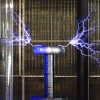Electromagnetic Induction and Tesla Coils: How It Works
Nikola Tesla is known as one of the greatest minds in science. His experiments helped to further the fields of electricity and magnetism, making many of the gadgets and luxuries we enjoy today possible. One of Tesla’s most well-known inventions is the Tesla coil, the first device that could transmit electricity without wires. The coil was created in 1891, before iron-core transformers existed.
Today, the Tesla coil structure can be found in some televisions and in laboratories.
 Image by Omegatron
Image by Omegatron
How does the Tesla coil work?
There are 6 main components of a Tesla coil: spark gap, capacitor, transformer, primary coil, secondary coil, and top load. Both the primary and secondary coils have their own capacitor, and are connected to each other by the spark gap. The spark gap is a space between two electrical conductors in which a “spark” passes. Spark plugs in a car have the gap, which helps to ignite fuel in engines. The diagram below shows the basic structure of the Tesla coil and its components. The torus is the top load. Image by Omegatron
Image by Omegatron
Tesla Coil Experiments
There are dozens of variations for how to create your own Tesla coil. However, constructing one can be a dangerous experiment. Only adults should attempt the construction and should do so in an outdoor space like a warehouse or garage, wearing protective gear and following specified safety precautions. Here are some of the supplies that you would need to create a simple experiment, learning about this magnificent invention, electricity and electromagnetic induction.Supplies
- PVC pipe (about 4 feet)
- Transformer/power source
- Wood (for base and spark gap)
- Copper wire
- Capacitor
- Nuts and bolts for spark gap
- Torus

